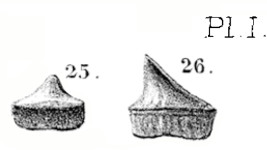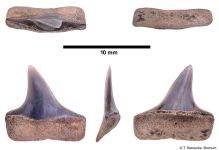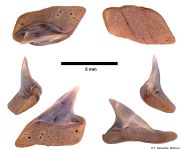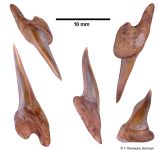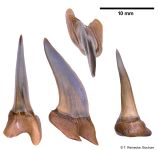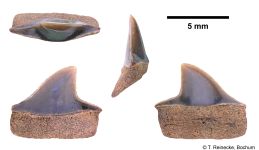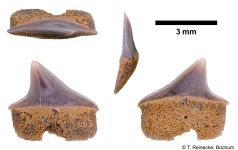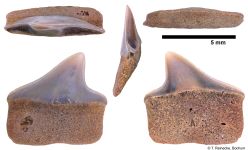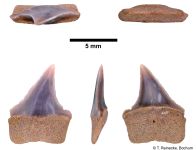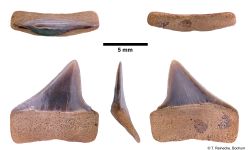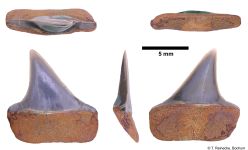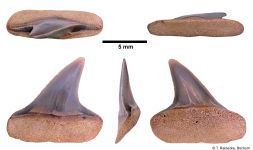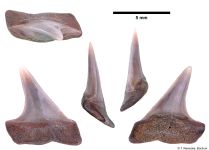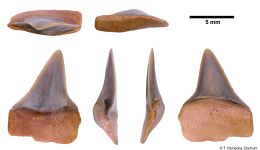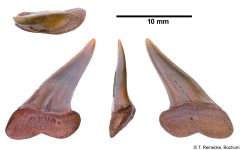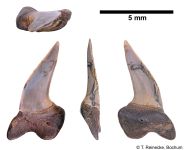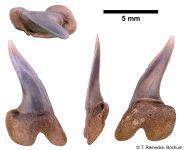Xiphodolamia ensis
Leidy, 1877
Classification: Elasmobranchii Lamniformes Xiphodolamiidae
Reference of the original description
Description of vertebrate remains, chiefly from the Phosphate Beds of South Carolina. Journal of the Academy of Natural Sciences of Philadelphia, 8(2), 209–261
Description of vertebrate remains, chiefly from the Phosphate Beds of South Carolina. Journal of the Academy of Natural Sciences of Philadelphia, 8(2), 209–261
Image of the original description

Xiphodolamia ensis Leidy, 1877; Syntypes, p. 252, pl. 34, figs 25-30, "Eocene Marls" of New Jersey, collected near Vincenttown; in Monmouth Co.; in Burlington Co.; and at Allowaystown, New Jersey

Xiphodolamia ensis Leidy, 1877; Syntypes, p. 252, pl. 34, figs 25-30, "Eocene Marls" of New Jersey, collected near Vincenttown; in Monmouth Co.; in Burlington Co.; and at Allowaystown, New Jersey
Synonyms / new combinations and misspellings
Carcharias (Scoliodon) eocaenus, Isurus eocaenus, Oxyrhina eocaena, Oxyrhina zignoi, Rhizoprionodon eocaenus, Xenodolamia barbadica, Xenodolamia eocaena, Xiphodolamia barbadica, Xiphodolamia eocaena, Xiphodolamia eocenica, Xiphodolamia zignoi, Xyphodolamia ensis
Carcharias (Scoliodon) eocaenus, Isurus eocaenus, Oxyrhina eocaena, Oxyrhina zignoi, Rhizoprionodon eocaenus, Xenodolamia barbadica, Xenodolamia eocaena, Xiphodolamia barbadica, Xiphodolamia eocaena, Xiphodolamia eocenica, Xiphodolamia zignoi, Xyphodolamia ensis
Description:
Citation: Xiphodolamia ensis Leidy, 1877: In: Database of fossil elasmobranch teeth www.shark-references.com, World Wide Web electronic publication, Version 12/2025
Please send your images of "Xiphodolamia ensis" to info@shark-references.com
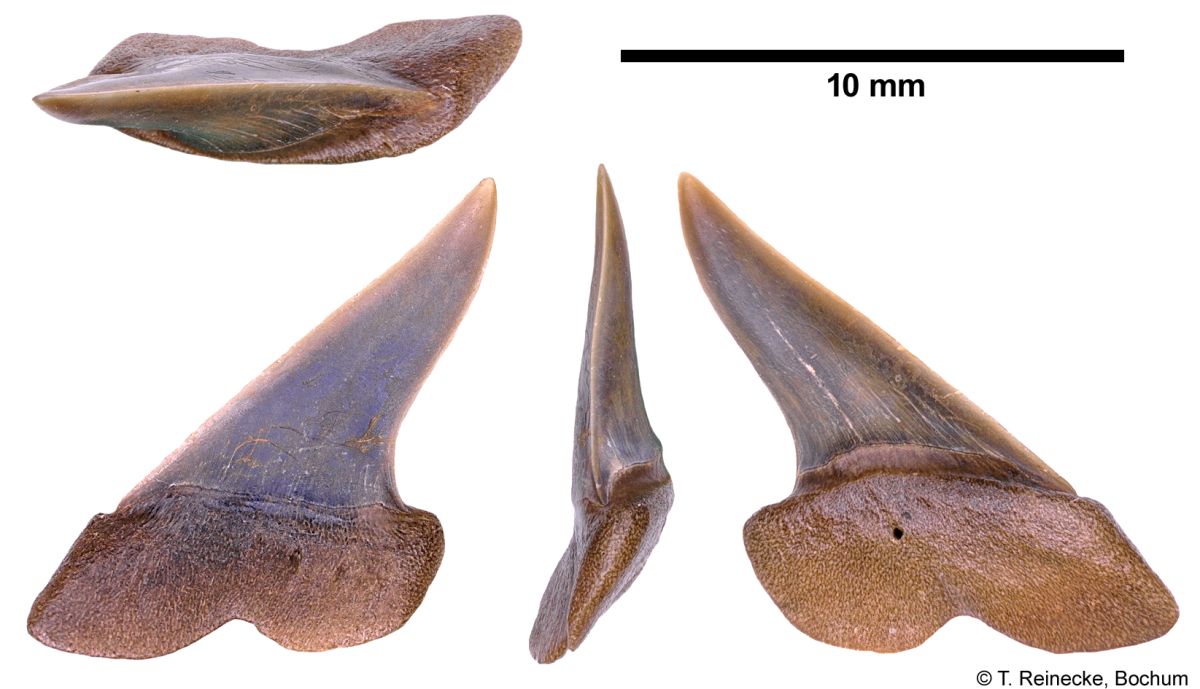
Xiphodolamia ensis Leidy, 1877; London Clay Formation, Division D, Sheppey Member, Ypresian, early Eocene; Cliff Reach Burnham-on-Crouch, Essex, UK; © and coll. T. Reinecke, Bochum

Xiphodolamia ensis Leidy, 1877; London Clay Formation, Division D, Sheppey Member, Ypresian, early Eocene; Cliff Reach Burnham-on-Crouch, Essex, UK; © and coll. T. Reinecke, Bochum
Description
Original diagnosis after Leidy (1877) p. 252: While engaged in describing some unusual forms of the teeth of Sharks, I take the opportunity of noticing another from the marls of New Jersey. The teeth to which I refer arc probably symphysial, but their relationship with lateral associates remains undetermined. The museum of the Academy contains twelve of these teeth, of which six are from Vincenttown, presented by Col. T. M. Bryan; four from Monmouth Co., presented by Dr. P. Knieskern; one from Burlington Co., presented by Dr. C. C. Abbott; and one from Allowaystown, presented by Dr. H. C. Yarrow. The teeth have the general appearance of those of Lamna laterally compressed. The crown of the tooth usually, as represented in figures 25-28, Plate xxxiv., has a sigmoid sabre-like form with the anterior bonier sharp and the posterior border obtuse. The root has the construction of that of a Lamna tooth, but the two sides appear pressed towards each other, so that the processes are directed obliquely and parallel. In some teeth, as in figure 27, the processes are nearly or quite equal; in other teeth, as in figures 25, 26, one process is shorter than the other. Figures 29 and 30 represent. transitional forms from that above indicated to the more ordinary one of Lamna teeth. In one of these, fig. 29, the crown is sharp a short distance below the point on the outer border, as it is the entire length along the inner border; in that of fig. 30 the crown is sharp along both borders. The root in both teeth is not laterally compressed, but has nearly the common form seen in most teeth of Sharks.
Original diagnosis after Leidy (1877) p. 252: While engaged in describing some unusual forms of the teeth of Sharks, I take the opportunity of noticing another from the marls of New Jersey. The teeth to which I refer arc probably symphysial, but their relationship with lateral associates remains undetermined. The museum of the Academy contains twelve of these teeth, of which six are from Vincenttown, presented by Col. T. M. Bryan; four from Monmouth Co., presented by Dr. P. Knieskern; one from Burlington Co., presented by Dr. C. C. Abbott; and one from Allowaystown, presented by Dr. H. C. Yarrow. The teeth have the general appearance of those of Lamna laterally compressed. The crown of the tooth usually, as represented in figures 25-28, Plate xxxiv., has a sigmoid sabre-like form with the anterior bonier sharp and the posterior border obtuse. The root has the construction of that of a Lamna tooth, but the two sides appear pressed towards each other, so that the processes are directed obliquely and parallel. In some teeth, as in figure 27, the processes are nearly or quite equal; in other teeth, as in figures 25, 26, one process is shorter than the other. Figures 29 and 30 represent. transitional forms from that above indicated to the more ordinary one of Lamna teeth. In one of these, fig. 29, the crown is sharp a short distance below the point on the outer border, as it is the entire length along the inner border; in that of fig. 30 the crown is sharp along both borders. The root in both teeth is not laterally compressed, but has nearly the common form seen in most teeth of Sharks.
Remarks
shark-references Species-ID=7528;
valid after Leidy (1877) p. 252 [1420]; Cicimurri & Ebersole (2021) p. 156 [30370]; Adnet et al. (2009) p. 3 [4105];
shark-references Species-ID=7528;
valid after Leidy (1877) p. 252 [1420]; Cicimurri & Ebersole (2021) p. 156 [30370]; Adnet et al. (2009) p. 3 [4105];
References

Fossil chondrichthyans of the Carpathian-Pannonian Region (in Hungarian: A Kárpát-Pannon-térség fosszilis porcoshalai). Hungarian Natural History Museum, Dabasi Nyomda Zrt., Budapest. 255 pages, ISBN 978-963-9877-52-8

Fossile hajtaender fra Trelde Naes. Self-published

New Paleogene elasmobranch (Chondrichthyes) records from the Gulf Coastal Plain of the United States, including a new species of Carcharhinus de Blainville, 1816. Cainozoic Research, 21(2), 147–164
Feeding ecology has shaped the evolution of modern sharks. Current Biology, 31(23), 5138–5148
DOI: 10.1016/j.cub.2021.09.028
Feeding ecology has shaped the evolution of modern sharks. Current Biology, 31(23), 5138–5148
DOI: 10.1016/j.cub.2021.09.028

A mesopelagic selachian fauna from the middle Eocene of St. Pankraz (Austria) reveals homogeneity in deep-marine environments during the warm period in Europe. Neues Jahrbuch für Geologie und Paläontologie, Abhandlungen, 301(1), 25–63
DOI: 10.1127/njgpa/2021/0996
Reassessment of historical sections from the Paleogene marine margin of the Congo Basin reveals an almost complete absence of Danian deposits. Geoscience Frontiers, 10(3), 1039-1063
DOI: 10.1016/j.gsf.2018.06.002

Climate cooling and clade competition likely drove the decline of lamniform sharks. Proceedings of the National Academy of Sciences of the United States of America, 116(41), 20584–20590
DOI: 10.1073/pnas.1902693116

The Turanian Basin in the Eocene: the new data on the fossil sharks and rays from the Kyzylkum Desert (Uzbekistan). Proceedings of the Zoological Institute, Russian Academy of Sciences, 320(1), 50–65

Chondrichthyans from a lag deposit between the Shark River Formation (Middle Eocene) and Kirkwood Formation (Early Miocene), Monmouth county, New Jersey. Paludicola, 10(3), 149–183
A study of the sharks and rays from the Lillebælt Clay (Early–Middle Eocene) of Denmark, and their palaeoecology. Bulletin of the Geological Society of Denmark, 62, 39–88
DOI: 10.37570/bgsd-2014-62-04

Pisces. In Piller, W.E. (ed.) Catalogus Fossilium Austriae, Band 3 - Verlag der Österreichischen Akademie der Wissenschaften, Wien, ISBN13: 978-3-7001-7238-3, 576 pp.

Présence des genres Xiphodolamia et Isistius (Chondrichthyes, Elasmobranchii) à l’Eocène du Bassin de Paris. Cossmanniana, 15, 85–98

The Aktulagay section, west Kazakhstan: a key site fornorthern mid-latitude Early Eocene stratigraphy. Stratigraphy, 10(3): 171–209

An overview of the Mexican fossil fish record. In G. Arratia, H.–P. Schultze & M.V.H. Wilson (Eds.), Mesozoic Fishes 5 – Global Diversity and Evolution (pp. 9–34). Verlag Dr. Friedrich Pfeil
Eocene (Lutetian) Shark-Rich Coastal Paleoenvironments of the Southern North Sea Basin in Europe: Biodiversity of the Marine Fürstenau Formation Including Early White and Megatooth Sharks. International Journal of Oceanography, 2012, Article ID 565326
DOI: 10.1155/2012/565326

The Elasmobranch Fauna of the Lede Sand Formation at Oosterzele (Lutetian, Middle Eocene of Belgium). Palaeofocus, 1, 1–57

London Clay Fossils of Kent and Essex. Rochester, Kent, Medway Fossil and Mineral Society, 228 p, ISBN: 978–0–9538243–1–1

Review of the enigmatic Eocene shark genus Xiphodolamia (Chondrichthyes, Lamniformes) and description of a new species recovered from Angola, Iran and Jordan. Journal of African Earth Sciences, 55(3–4), 197–204
DOI: 10.1016/j.jafrearsci.2009.04.005

Review of the enigmatic Eocene shark genus Xiphodolamia (Chondrichthyes, Lamniformes) and description of a new species recovered from Angola, Iran and Jordan. Journal of African Earth Sciences, 55(3–4), 197–204
DOI: 10.1016/j.jafrearsci.2009.04.005

(Elasmobranchs of the western margin of the West Siberian Paleogene basin.) «in russian». Ekaterinburg: IGG UB RAS, 2006, 224 p., ICC 5–94332–048–2

Review of the Middle Eocene (Lutetian) selachian fauna of Jebal eth Thuleithuwat, east Jordan. Neues Jahrbuch für Geologie und Paläontologie, Abhandlungen, 237(3), 399–422

Middle Eocene selachian fauna from Wadi Al-Rijla Al-Bayda, Eastern Desert of Jordan. Abhath Al–Yamouk Basic Sciences and Engineering, 12(2b), 619–631
Descripción de asociaciones faunísticas de elasmobranquios fósiles del eoceno superior (Priaboniano) de las formaciones Tepetate y Bateque de Baja California Sur, México. unpublished Thesis, La Paz, Centro Interdisciplinario de Ciencias Marinas. XIII, 226 p.

Report of Field Meeting to Burnham-on-Crouch, Essex. Tertiary Research, 22(1-4), 89–92

Asociaciones faunisticas de condrictios en el Cenozoico de la Peninsula de Baja California, Mexico. Profil, 18: 1–4

London Clay Fossils of the Isle of Sheppey. Medway Lapidary and Mineral Society, ISBN 0-9538243-0-6, 100pp.

Angaben zur Hai- und Rochenfauna aus dem Eozän von Turnu Roșu (Rumänien). Naturwissenschaftliche Forschung über Siebenburgen VI. Beitrage zur Geographie, Botanik, Zoologie und Palaontologie. Siebenburgisches Archiv, 36, 265–270

Tertiärfossilien Österreichs: Wirbellose, niedere Wirbeltiere und marine Säugetiere. 159 S., 4 Karten, 65 Tat., Korb(Goldschneck–Verlag).

Colecţia de selacieni - Richard Breckner [Richard Breckner selachian collection]. Studii şi comunicări, Științele Naturii, Muzeul Brukenthal, 28: 115–119

Xiphodolamia eocaena (Woodward, 1889) - a new species for Romania. Studii şi cercetări, Muzeul Bistriţa-Năsăud, 2: 83–89

De visfauna uit de basis van de Klei van Egemkapel in de groeve Ampe te Egem (onder eoceen van Noordwest -Belgie) Tielt, 1994

Fossil Sharks of the Chesapeake Bay Region. Egan Rees and Boyer, Inc. Columbia. 146 pp.

Soortenlijst van fossiele vissen uit het Eoceen van België. Afzettingen WTKG, 15(4), 6–12

Die Neoselachier der Paleokaribik (Pisces: Elasmobranchii). Courier Forschungsinstitut Senckenberg, 119, 1–102


Fossiles de Belgique. Dents de Requins et de Raies du Tertiaire de la Belgique. Institut royal des Sciences naturelles de Belgique, 184 pp.

Une riche faune de sélaciens dans le bassin à phosphate de Kpogamé-Hahotoé (Éocène moyen du Togo): Note préliminaire et précisions sur la structure et l'âge du gisement. Geobios, 21(3), 359–365
DOI: 10.1016/S0016-6995(88)80058-5

Stand der Untersuchungen an der Chondrichthyes-Fauna des nordwestdeutschen Tertiärs. Beiträge zur regionalen Geologie der Erde, 18, 503–509


Haaie- en Roggentanden uit het Tertiair van Belgie. Institut royal des Sciences naturelles de Belgique, 1–171
Elasmobranch teeth (Vertebrata, Pisces) from the Dongen Formation (Eocene) in the Netherlands. Mededelingen Van De Werkgroep Voor Tertiaire En Kwartaire Geologie, 22(2), 73–122

Fossil sharks, rays and chimaeroids of the English Tertiary period. Gosport Museum, 1–47, 10 fig., 3 tabl., 16 pl.

The distribution of sharks, rays and chimaeroids in the English Palaeogene. Tertiary Research, 3(1), 13–19

Eine Lagerstätte kreidezeitlicher und paläogener Chondrichthyes-Reste bei Fürstenau (Niedersachsen). Osnabrücker Naturwissenschaftliche Mitteilungen, 6, 35–44

Het Eoceen in de lokaalmoraine van Losser. Staringia, 4: 3-39
The Teeth of Sharks on the Floor of the Pacific Ocean. Trudy Instituta Okaenologii, Academiia Nauk SSSR, 88, 236–276

Faune ichthyologique du London Clay. Trustees of the British Museum: 496 pp., 82 fig., 68 pl.

O Neocretácio e o Cenozóico do Litoral de Angola. Junta Invest. Ultramar, Lisboa, 254 pp, 27 pl., 25 tabl.

Les poissons fossiles du Bas-Congo et des régions voisines. Annales du Musée du Congo Belge, Sér. A (Minéralogie Géologie, Paléontologie), 3, 2(3): 257–568

Contribution à l'étude des poissons fossiles des Antilles. Mémoires Suisses de Paléontologie, 74, 1–95

Les faunes ichthyologiques du Crétacé et du Cénozoïque de l'Angola et de l'Enclave de Cabinda. Leurs affinités paléobiogéographiques. Comunicações dos Serviços Geológicos de Portugal, 38(2), 269–290

Check list of the fossil fishes of New Jersey. Journal of Paleontology, 20(5), 510–513

Les Sélaciens du Paléogène de Manghyschlak, d'Emba et du versant oriental d'Oural. «in russian». Bulletin de la Société Impériale des Naturalistes de Moscou, Section Géologique, 6(3–4), 292–338

Extinct Vertebrates from Beaumaris. Victorian Naturalist, 43(3), 78–82

Some Cainozoic fish remains, vvith a revision of the group. Proceedings of the Royal Society of Victoria, 36, 107–162
A description of the fossil fish remains of the Cretaceous, Eocene and Miocene formations of New-Jersey. Geological Survey of New Jersey Bulletin, 4: 182 p., 108 fig.
Contribution à lètude des poisons fossils du Nord de la France et des regions voisines. Mémoires de la Société géologique du Nord, 5, 1–430
Les poissons éocènes de la Belgique. Mémoires du Musée Royal d'Histoire Naturelle de Belgique, 3(11), 49–228

Fossil fish remains from the Tertiaries of Australia. Proceedings of the Royal Society of Victoria, 17, 267–297

Bibliography and catalogue of the fossil Vertebrata of North America. Bulletin of the United States Geological and Geographical Survey of the Territories, 179, 1–868

Notes on the teeth of sharks and skates from English Eocene formations. Proceedings of the Geologists' Association, 16(1), 1–14, pl. 1.
DOI: 10.1016/S0016-7878(99)80036-4

Catalogue of the fossil fishes in the British Museum. Part. I. British Museum (Natural History): 474 p., fig., 17 pl.

Ittiodontoliti del Veneto. Atti Accademia Scientifica Veneto-Trentino-Istriana, 5, 275–308

Description of vertebrate remains, chiefly from the Phosphate Beds of South Carolina. Journal of the Academy of Natural Sciences of Philadelphia, 8(2), 209–261

Fossil chondrichthyans of the Carpathian-Pannonian Region (in Hungarian: A Kárpát-Pannon-térség fosszilis porcoshalai). Hungarian Natural History Museum, Dabasi Nyomda Zrt., Budapest. 255 pages, ISBN 978-963-9877-52-8

Fossile hajtaender fra Trelde Naes. Self-published

New Paleogene elasmobranch (Chondrichthyes) records from the Gulf Coastal Plain of the United States, including a new species of Carcharhinus de Blainville, 1816. Cainozoic Research, 21(2), 147–164
Feeding ecology has shaped the evolution of modern sharks. Current Biology, 31(23), 5138–5148
DOI: 10.1016/j.cub.2021.09.028
Feeding ecology has shaped the evolution of modern sharks. Current Biology, 31(23), 5138–5148
DOI: 10.1016/j.cub.2021.09.028

A mesopelagic selachian fauna from the middle Eocene of St. Pankraz (Austria) reveals homogeneity in deep-marine environments during the warm period in Europe. Neues Jahrbuch für Geologie und Paläontologie, Abhandlungen, 301(1), 25–63
DOI: 10.1127/njgpa/2021/0996
Reassessment of historical sections from the Paleogene marine margin of the Congo Basin reveals an almost complete absence of Danian deposits. Geoscience Frontiers, 10(3), 1039-1063
DOI: 10.1016/j.gsf.2018.06.002

Climate cooling and clade competition likely drove the decline of lamniform sharks. Proceedings of the National Academy of Sciences of the United States of America, 116(41), 20584–20590
DOI: 10.1073/pnas.1902693116

The Turanian Basin in the Eocene: the new data on the fossil sharks and rays from the Kyzylkum Desert (Uzbekistan). Proceedings of the Zoological Institute, Russian Academy of Sciences, 320(1), 50–65

Chondrichthyans from a lag deposit between the Shark River Formation (Middle Eocene) and Kirkwood Formation (Early Miocene), Monmouth county, New Jersey. Paludicola, 10(3), 149–183
A study of the sharks and rays from the Lillebælt Clay (Early–Middle Eocene) of Denmark, and their palaeoecology. Bulletin of the Geological Society of Denmark, 62, 39–88
DOI: 10.37570/bgsd-2014-62-04

Pisces. In Piller, W.E. (ed.) Catalogus Fossilium Austriae, Band 3 - Verlag der Österreichischen Akademie der Wissenschaften, Wien, ISBN13: 978-3-7001-7238-3, 576 pp.

Présence des genres Xiphodolamia et Isistius (Chondrichthyes, Elasmobranchii) à l’Eocène du Bassin de Paris. Cossmanniana, 15, 85–98

The Aktulagay section, west Kazakhstan: a key site fornorthern mid-latitude Early Eocene stratigraphy. Stratigraphy, 10(3): 171–209

An overview of the Mexican fossil fish record. In G. Arratia, H.–P. Schultze & M.V.H. Wilson (Eds.), Mesozoic Fishes 5 – Global Diversity and Evolution (pp. 9–34). Verlag Dr. Friedrich Pfeil
Eocene (Lutetian) Shark-Rich Coastal Paleoenvironments of the Southern North Sea Basin in Europe: Biodiversity of the Marine Fürstenau Formation Including Early White and Megatooth Sharks. International Journal of Oceanography, 2012, Article ID 565326
DOI: 10.1155/2012/565326

The Elasmobranch Fauna of the Lede Sand Formation at Oosterzele (Lutetian, Middle Eocene of Belgium). Palaeofocus, 1, 1–57

London Clay Fossils of Kent and Essex. Rochester, Kent, Medway Fossil and Mineral Society, 228 p, ISBN: 978–0–9538243–1–1

Review of the enigmatic Eocene shark genus Xiphodolamia (Chondrichthyes, Lamniformes) and description of a new species recovered from Angola, Iran and Jordan. Journal of African Earth Sciences, 55(3–4), 197–204
DOI: 10.1016/j.jafrearsci.2009.04.005

Review of the enigmatic Eocene shark genus Xiphodolamia (Chondrichthyes, Lamniformes) and description of a new species recovered from Angola, Iran and Jordan. Journal of African Earth Sciences, 55(3–4), 197–204
DOI: 10.1016/j.jafrearsci.2009.04.005

(Elasmobranchs of the western margin of the West Siberian Paleogene basin.) «in russian». Ekaterinburg: IGG UB RAS, 2006, 224 p., ICC 5–94332–048–2

Review of the Middle Eocene (Lutetian) selachian fauna of Jebal eth Thuleithuwat, east Jordan. Neues Jahrbuch für Geologie und Paläontologie, Abhandlungen, 237(3), 399–422

Middle Eocene selachian fauna from Wadi Al-Rijla Al-Bayda, Eastern Desert of Jordan. Abhath Al–Yamouk Basic Sciences and Engineering, 12(2b), 619–631
Descripción de asociaciones faunísticas de elasmobranquios fósiles del eoceno superior (Priaboniano) de las formaciones Tepetate y Bateque de Baja California Sur, México. unpublished Thesis, La Paz, Centro Interdisciplinario de Ciencias Marinas. XIII, 226 p.

Report of Field Meeting to Burnham-on-Crouch, Essex. Tertiary Research, 22(1-4), 89–92

Asociaciones faunisticas de condrictios en el Cenozoico de la Peninsula de Baja California, Mexico. Profil, 18: 1–4

London Clay Fossils of the Isle of Sheppey. Medway Lapidary and Mineral Society, ISBN 0-9538243-0-6, 100pp.

Angaben zur Hai- und Rochenfauna aus dem Eozän von Turnu Roșu (Rumänien). Naturwissenschaftliche Forschung über Siebenburgen VI. Beitrage zur Geographie, Botanik, Zoologie und Palaontologie. Siebenburgisches Archiv, 36, 265–270

Tertiärfossilien Österreichs: Wirbellose, niedere Wirbeltiere und marine Säugetiere. 159 S., 4 Karten, 65 Tat., Korb(Goldschneck–Verlag).

Colecţia de selacieni - Richard Breckner [Richard Breckner selachian collection]. Studii şi comunicări, Științele Naturii, Muzeul Brukenthal, 28: 115–119

Xiphodolamia eocaena (Woodward, 1889) - a new species for Romania. Studii şi cercetări, Muzeul Bistriţa-Năsăud, 2: 83–89

De visfauna uit de basis van de Klei van Egemkapel in de groeve Ampe te Egem (onder eoceen van Noordwest -Belgie) Tielt, 1994

Fossil Sharks of the Chesapeake Bay Region. Egan Rees and Boyer, Inc. Columbia. 146 pp.

Soortenlijst van fossiele vissen uit het Eoceen van België. Afzettingen WTKG, 15(4), 6–12

Die Neoselachier der Paleokaribik (Pisces: Elasmobranchii). Courier Forschungsinstitut Senckenberg, 119, 1–102


Fossiles de Belgique. Dents de Requins et de Raies du Tertiaire de la Belgique. Institut royal des Sciences naturelles de Belgique, 184 pp.

Une riche faune de sélaciens dans le bassin à phosphate de Kpogamé-Hahotoé (Éocène moyen du Togo): Note préliminaire et précisions sur la structure et l'âge du gisement. Geobios, 21(3), 359–365
DOI: 10.1016/S0016-6995(88)80058-5

Stand der Untersuchungen an der Chondrichthyes-Fauna des nordwestdeutschen Tertiärs. Beiträge zur regionalen Geologie der Erde, 18, 503–509


Haaie- en Roggentanden uit het Tertiair van Belgie. Institut royal des Sciences naturelles de Belgique, 1–171
Elasmobranch teeth (Vertebrata, Pisces) from the Dongen Formation (Eocene) in the Netherlands. Mededelingen Van De Werkgroep Voor Tertiaire En Kwartaire Geologie, 22(2), 73–122

Fossil sharks, rays and chimaeroids of the English Tertiary period. Gosport Museum, 1–47, 10 fig., 3 tabl., 16 pl.

The distribution of sharks, rays and chimaeroids in the English Palaeogene. Tertiary Research, 3(1), 13–19

Eine Lagerstätte kreidezeitlicher und paläogener Chondrichthyes-Reste bei Fürstenau (Niedersachsen). Osnabrücker Naturwissenschaftliche Mitteilungen, 6, 35–44

Het Eoceen in de lokaalmoraine van Losser. Staringia, 4: 3-39
The Teeth of Sharks on the Floor of the Pacific Ocean. Trudy Instituta Okaenologii, Academiia Nauk SSSR, 88, 236–276

Faune ichthyologique du London Clay. Trustees of the British Museum: 496 pp., 82 fig., 68 pl.

O Neocretácio e o Cenozóico do Litoral de Angola. Junta Invest. Ultramar, Lisboa, 254 pp, 27 pl., 25 tabl.

Les poissons fossiles du Bas-Congo et des régions voisines. Annales du Musée du Congo Belge, Sér. A (Minéralogie Géologie, Paléontologie), 3, 2(3): 257–568

Contribution à l'étude des poissons fossiles des Antilles. Mémoires Suisses de Paléontologie, 74, 1–95

Les faunes ichthyologiques du Crétacé et du Cénozoïque de l'Angola et de l'Enclave de Cabinda. Leurs affinités paléobiogéographiques. Comunicações dos Serviços Geológicos de Portugal, 38(2), 269–290

Check list of the fossil fishes of New Jersey. Journal of Paleontology, 20(5), 510–513

Les Sélaciens du Paléogène de Manghyschlak, d'Emba et du versant oriental d'Oural. «in russian». Bulletin de la Société Impériale des Naturalistes de Moscou, Section Géologique, 6(3–4), 292–338

Extinct Vertebrates from Beaumaris. Victorian Naturalist, 43(3), 78–82

Some Cainozoic fish remains, vvith a revision of the group. Proceedings of the Royal Society of Victoria, 36, 107–162
A description of the fossil fish remains of the Cretaceous, Eocene and Miocene formations of New-Jersey. Geological Survey of New Jersey Bulletin, 4: 182 p., 108 fig.
Contribution à lètude des poisons fossils du Nord de la France et des regions voisines. Mémoires de la Société géologique du Nord, 5, 1–430
Les poissons éocènes de la Belgique. Mémoires du Musée Royal d'Histoire Naturelle de Belgique, 3(11), 49–228

Fossil fish remains from the Tertiaries of Australia. Proceedings of the Royal Society of Victoria, 17, 267–297

Bibliography and catalogue of the fossil Vertebrata of North America. Bulletin of the United States Geological and Geographical Survey of the Territories, 179, 1–868

Notes on the teeth of sharks and skates from English Eocene formations. Proceedings of the Geologists' Association, 16(1), 1–14, pl. 1.
DOI: 10.1016/S0016-7878(99)80036-4

Catalogue of the fossil fishes in the British Museum. Part. I. British Museum (Natural History): 474 p., fig., 17 pl.

Ittiodontoliti del Veneto. Atti Accademia Scientifica Veneto-Trentino-Istriana, 5, 275–308

Description of vertebrate remains, chiefly from the Phosphate Beds of South Carolina. Journal of the Academy of Natural Sciences of Philadelphia, 8(2), 209–261








